14.12.2024
NASA Successfully Integrates Roman Mission’s Telescope, Instruments
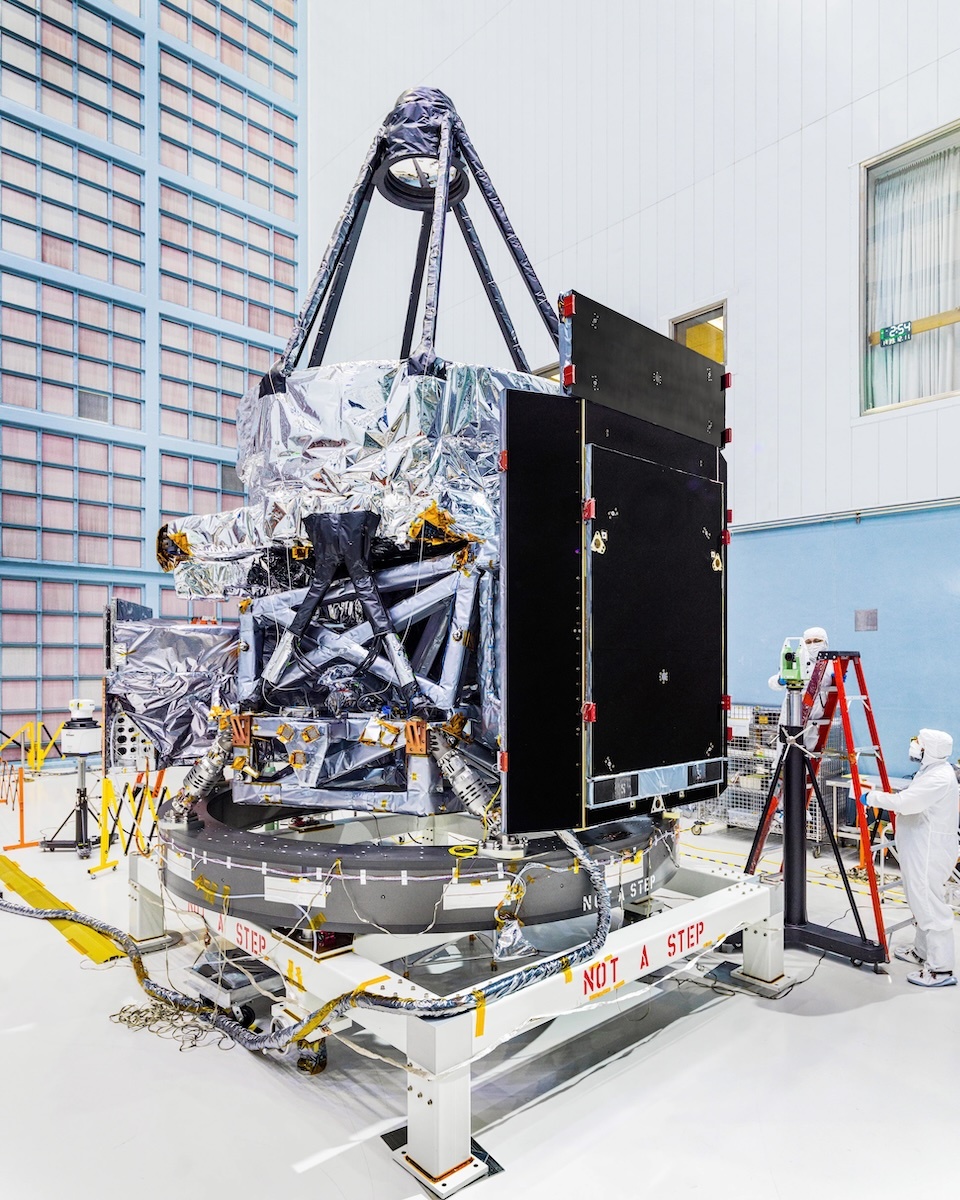
The telescope and instruments for NASA’s Nancy Grace Roman Space Telescope were recently integrated together on the observatory’s instrument carrier at the agency’s Goddard Space Flight Center in Greenbelt, Md. Next, the entire system will be joined to the Roman spacecraft.
NASA’s Nancy Grace Roman Space Telescope team has successfully integrated the mission’s telescope and two instruments onto the instrument carrier, marking the completion of the Roman payload. Now the team at NASA’s Goddard Space Flight Center in Greenbelt, Maryland, will begin joining the payload to the spacecraft.
“We’re in the middle of an exciting stage of mission preparation,” said Jody Dawson, a Roman systems engineer at NASA Goddard. “All the components are now here at Goddard, and they’re coming together in quick succession. We expect to integrate the telescope and instruments with the spacecraft before the year is up.”
Engineers first integrated the Coronagraph Instrument, a technology demonstration designed to image exoplanets — worlds outside our solar system — by using a complex suite of masks and active mirrors to obscure the glare of the planets’ host stars.
Then the team integrated the Optical Telescope Assembly, which includes a 7.9-foot (2.4-meter) primary mirror, nine additional mirrors, and their supporting structures and electronics. The telescope will focus cosmic light and send it to Roman’s instruments, revealing billions of objects strewn throughout space and time. Roman will be the most stable large telescope ever built, at least 10 times more so than NASA’s James Webb Space Telescope and 100 times more than the agency’s Hubble Space Telescope. This will allow scientists to make measurements at levels of precision that can answer important questions about dark energy, dark matter, and worlds beyond our solar system.
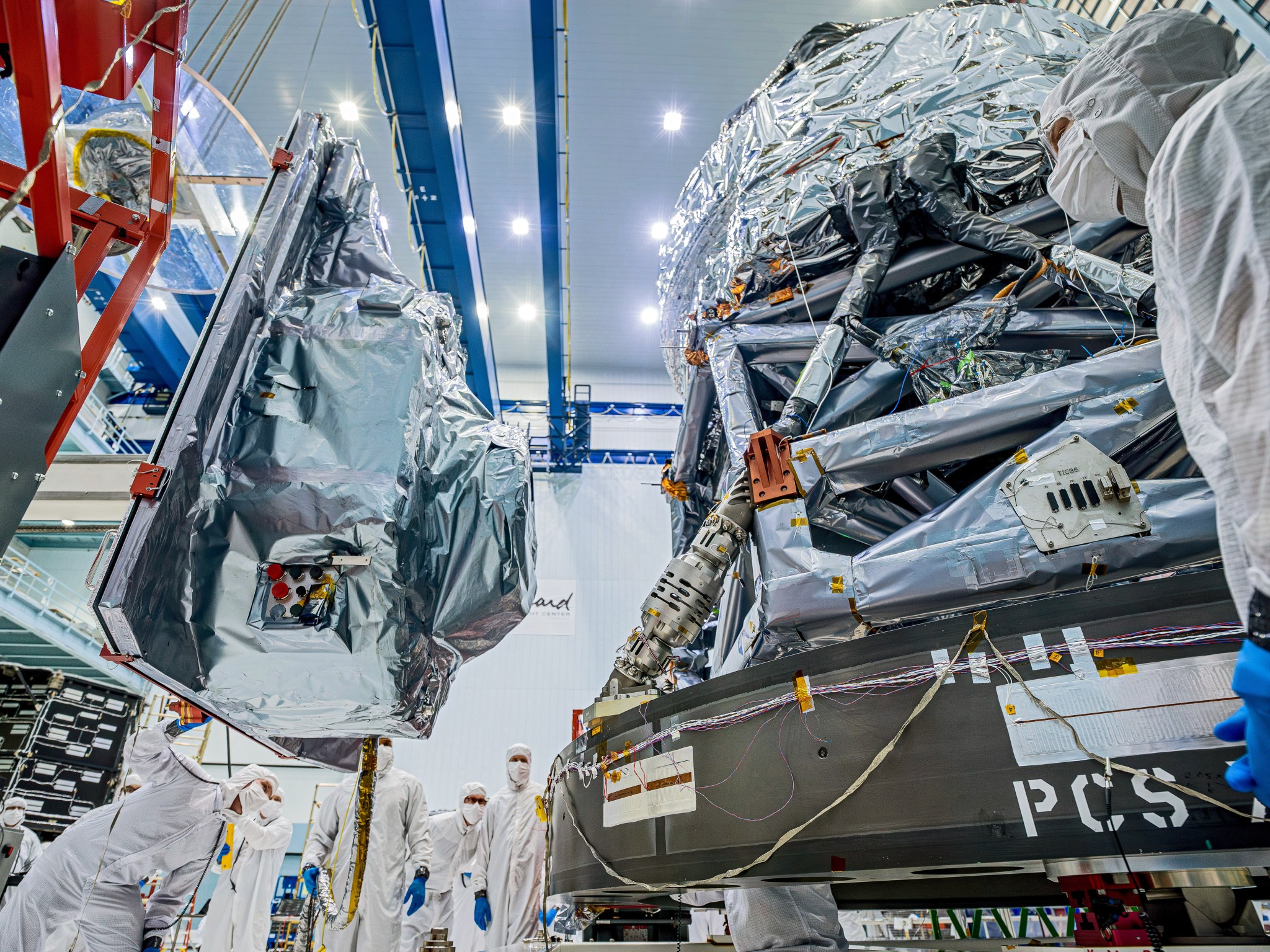
With those components in place, the team then added Roman’s primary instrument. Called the Wide Field Instrument, this 300-megapixel infrared camera will give Roman a deep, panoramic view of the universe. Through the Wide Field Instrument’s surveys, scientists will be able to explore distant exoplanets, stars, galaxies, black holes, dark energy, dark matter, and more. Thanks to this instrument and the observatory’s efficiency, Roman will be able to image large areas of the sky 1,000 times faster than Hubble with the same sharp, sensitive image quality.
“It would be quicker to list the astronomy topics Roman won’t be able to address than those it will,” said Julie McEnery, the Roman senior project scientist at NASA Goddard. “We’ve never had a tool like this before. Roman will revolutionize the way we do astronomy.”
The telescope and instruments were mounted to Roman’s instrument carrier and precisely aligned in the largest clean room at Goddard, where the observatory is being assembled. Now, the whole assembly is being attached to the Roman spacecraft, which will deliver the observatory to its orbit and enable it to function once there.
At the same time, the mission’s deployable aperture cover — a visor that will shield the telescope from unwanted light — is being joined to the outer barrel assembly, which serves as the telescope’s exoskeleton.
“We’ve had an incredible year, and we’re looking forward to another one!” said Bear Witherspoon, a Roman systems engineer at NASA Goddard. “While the payload and spacecraft undergo a smattering of testing together, the team will work toward integrating the solar panels onto the outer barrel assembly.”
That keeps the observatory on track for completion by fall 2026 and launch no later than May 2027.
Quelle: NASA
----
Update: 10.01.2025
.
NASA Joins Telescope, Instruments to Roman Spacecraft
Technicians have successfully integrated NASA’s Nancy Grace Roman Space Telescope’s payload – the telescope, instrument carrier, and two instruments – to the spacecraft that will deliver the observatory to its place in space and enable it to function while there.
“With this incredible milestone, Roman remains on track for launch, and we’re a big step closer to unveiling the cosmos as never before,” said Mark Clampin, acting deputy associate administrator for the Science Mission Directorate at NASA Headquarters in Washington. “It’s been fantastic to watch the team’s progress throughout the integration phase. I look forward to Roman’s transformative observations.”
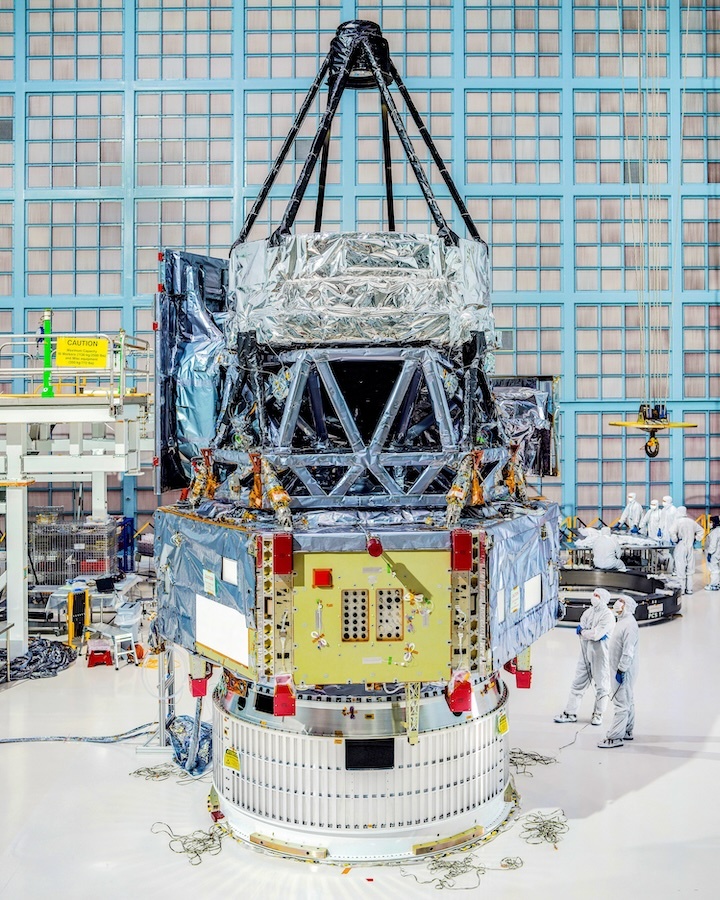
The newly joined space hardware will now undergo extensive testing. The first test will ensure each major element operates as designed when integrated with the rest of the observatory and establish the hardware’s combined performance. Then environmental tests will subject the payload to the electromagnetic, vibration, and thermal vacuum environments it will experience during launch and on-orbit operations. These tests will ensure the hardware and the launch vehicle will not interfere with each other when operating, verify the communications antennas won’t create electromagnetic interference with other observatory hardware, shake the assembly to make sure it will survive extreme vibration during launch, assess its performance across its expected range of operating temperatures, and make sure the instruments and mirrors are properly optically aligned.
Meanwhile, Roman’s deployable aperture cover will be integrated with the outer barrel assembly, and then the solar panels will be added before spring. Then the structure will be joined to the payload and spacecraft this fall.
The Roman mission remains on track for completion by fall 2026 and launch no later than May 2027.
Quelle: NASA
----
Update: 14.02.2025
.
NASA Successfully Joins Sunshade to Roman Observatory’s ‘Exoskeleton’
NASA’s Nancy Grace Roman Space Telescope team has successfully integrated the mission’s deployable aperture cover — a visor-like sunshade that will help prevent unwanted light from entering the telescope — to the outer barrel assembly, another structure designed to shield the telescope from stray light in addition to keeping it at a stable temperature.
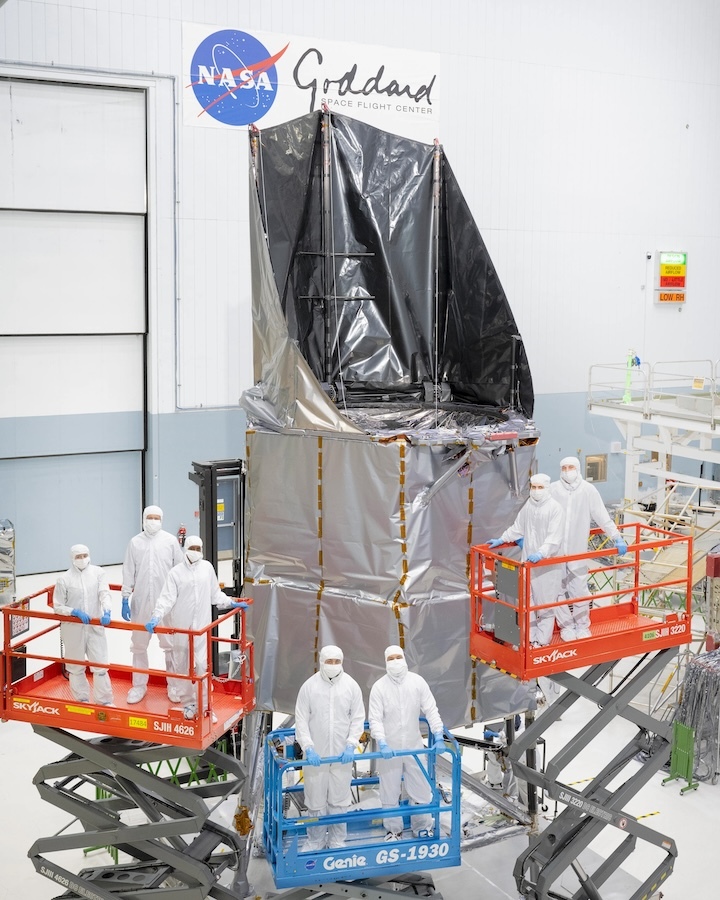
“It’s been incredible to see these major components go from computer models to building and now integrating them,” said Sheri Thorn, an aerospace engineer working on Roman’s sunshade at NASA’s Goddard Space Flight Center in Greenbelt, Maryland. “Since it’s all coming together at Goddard, we get a front row seat to the process. We’ve seen it mature, kind of like watching a child grow up, and it’s a really gratifying experience.”
The sunshade functions like a heavy-duty version of blackout curtains you might use to keep your room extra dark. It will make Roman more sensitive to faint light from across the universe, helping astronomers see dimmer and farther objects. Made of two layers of reinforced thermal blankets, the sunshade is designed to remain folded during launch and deploy after Roman is in space. Three booms will spring upward when triggered electronically, raising the sunshade like a page in a pop-up book.
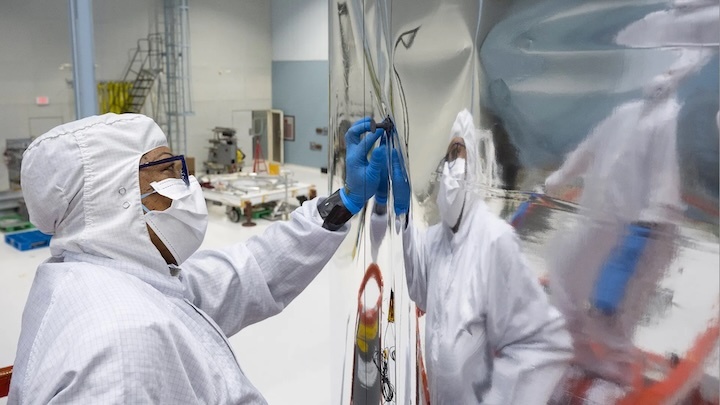
Over the course of a few hours, technicians meticulously joined the sunshade to the outer barrel assembly — both Goddard-designed components — in the largest clean room at NASA Goddard. The outer barrel assembly will help keep the telescope at a stable temperature and, like the sunshade, help shield the telescope from stray light and micrometeoroid impacts. It’s fitted with heaters to help ensure the telescope’s mirrors won’t experience wide temperature swings, which make materials expand and contract.
“Roman is made up of a lot of separate components that come together after years of design and fabrication,” said Laurence Madison, a mechanical engineer at NASA Goddard. “The deployable aperture cover and outer barrel assembly were built at the same time, and up until the integration the two teams mainly used reference drawings to make sure everything would fit together as they should. So the successful integration was both a proud moment and a relief!”
“Since the sunshade was designed to deploy in space, the system isn’t actually strong enough to deploy itself in Earth’s gravity,” said Matthew Neuman, a mechanical engineer working on Roman’s sunshade at NASA Goddard. “So we used a gravity negation system to offset its weight and verified that everything works as expected.”
Next, the components will undergo thermal vacuum testing together to ensure they will function as planned in the temperature and pressure environment of space. Then they’ll move to a shake test to assess their performance during the extreme vibrations they’ll experience during launch.
Technicians will join Roman’s solar panels to the outer barrel assembly and sunshade this spring, and then integrate them with the rest of the observatory by the end of the year.
The mission has now passed a milestone called Key Decision Point-D, marking the official transition from the fabrication stage that culminated in the delivery of major components to the phase involving assembly, integration, testing, and launch. The Roman observatory remains on track for completion by fall 2026 and launch no later than May 2027.
NASA’s Roman Mission Shares Detailed Plans to Scour Skies
NASA’s Nancy Grace Roman Space Telescope team shared Thursday the designs for the three core surveys the mission will conduct after launch. These observation programs are designed to investigate some of the most profound mysteries in astrophysics while enabling expansive cosmic exploration that will revolutionize our understanding of the universe.
“Roman’s setting out to do wide, deep surveys of the universe in a way that will help us answer questions about how dark energy and dark matter govern cosmic evolution, and the demographics of worlds beyond our solar system,” said Gail Zasowski, an associate professor at the University of Utah and co-chair of the ROTAC (Roman Observations Time Allocation Committee). “But the overarching goal is that the surveys have broad appeal and numerous science applications. They were designed by and for the astronomical community to maximize the science they’ll enable.”
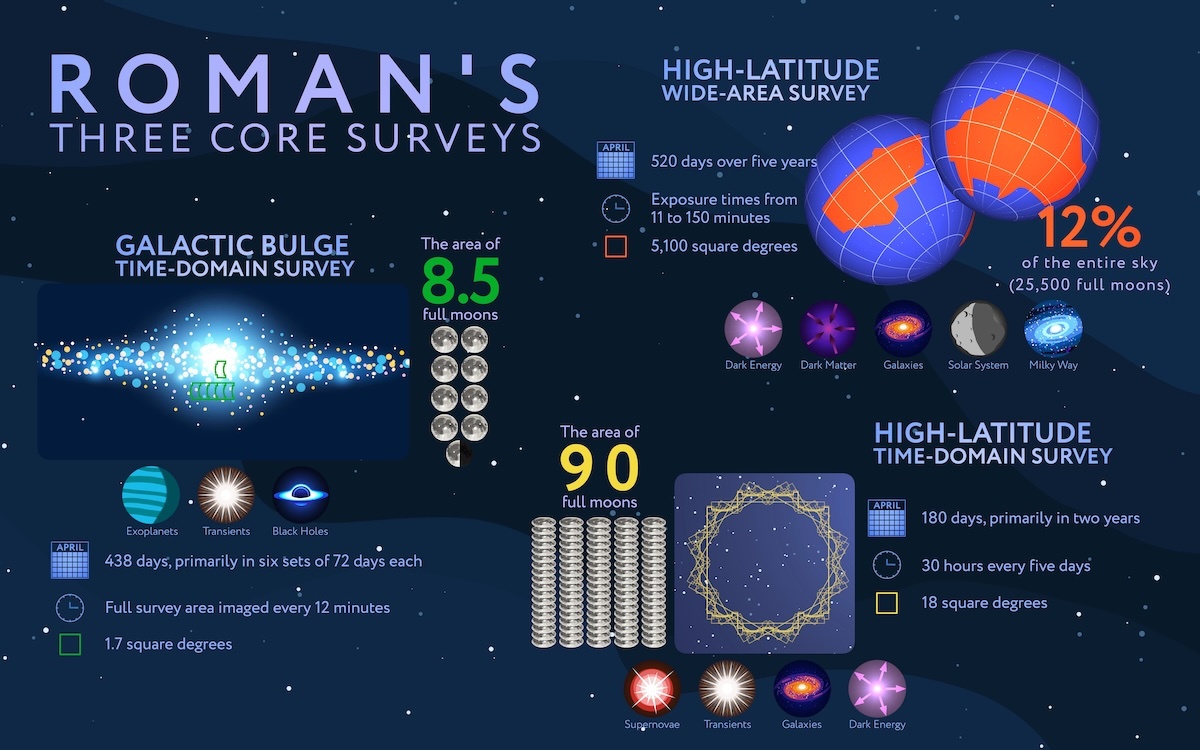
Roman’s crisp, panoramic view of space and fast survey speeds provide the opportunity for astronomers to study the universe as never before. The Roman team asked the science community to detail the topics they’d like to study through each of Roman’s surveys and selected committees of scientists across many organizations to evaluate the range of possibilities and formulate three compelling options for each.
In April, the Roman team received the recommendations and has now determined the survey designs. These observations account for no more than 75 percent of Roman’s surveys during its five-year primary mission, with the remainder allocated to additional observations that will be proposed and developed by the science community in later opportunities.
“These survey designs are the culmination of two years of input from more than 1,000 scientists from over 350 institutions across the globe,” said Julie McEnery, Roman’s senior project scientist at NASA Goddard. “We’re thrilled that we’ve been able to hear from so many of the people who’ll use the data after launch to investigate everything from objects in our outer solar system, planets across our galaxy, dark matter and dark energy, to exploding stars, growing black holes, galaxies by the billions, and so much more.”
With all major hardware now delivered, Roman has entered its final phase of preparation for launch, undergoing integration and key environmental testing at NASA Goddard. Roman is targeted to launch by May 2027, with the team working toward a potential launch as early as October 2026.
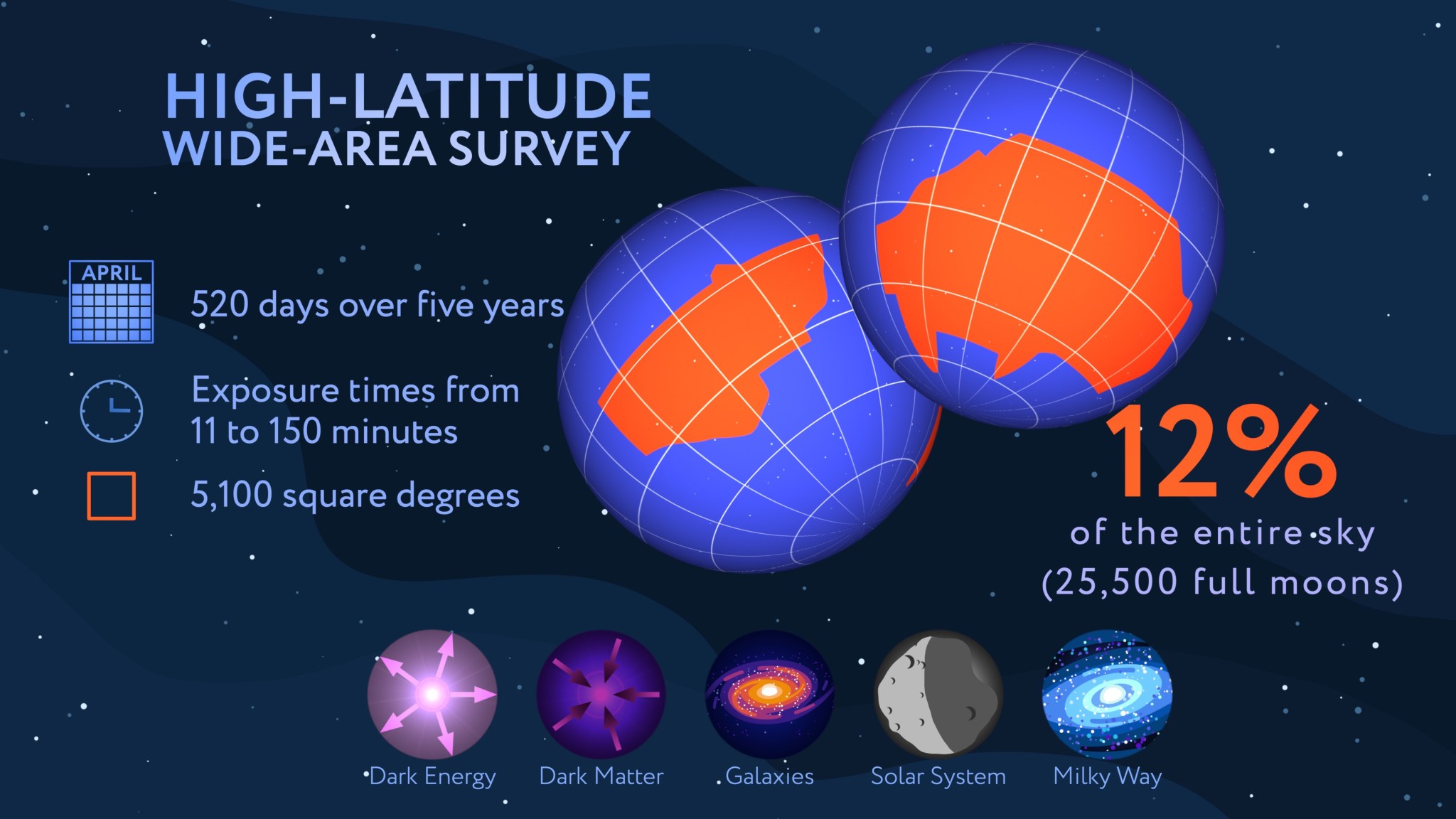
High-Latitude Wide-Area Survey
Roman’s largest survey, the High-Latitude Wide-Area Survey, combines the powers of imaging and spectroscopy to unveil more than a billion galaxies strewn across a wide swath of cosmic time. Roman can look far from the dusty plane of our Milky Way galaxy (that’s what the “high-latitude” part of the survey name means), looking up and out of the galaxy rather than through it to get the clearest view of the distant cosmos.
The distribution and shapes of galaxies in Roman’s enormous, deep images can help us understand the nature of dark energy — a pressure that seems to be speeding up the universe’s expansion — and how invisible dark matter, which Roman will detect by its gravitational effects, influences the evolution of structure in our universe.
For the last two years, researchers have been discussing ways to expand the range of scientific topics that can be studied using the same dataset. That includes studying galaxy evolution, star formation, cosmic voids, the matter between galaxies, and much more.
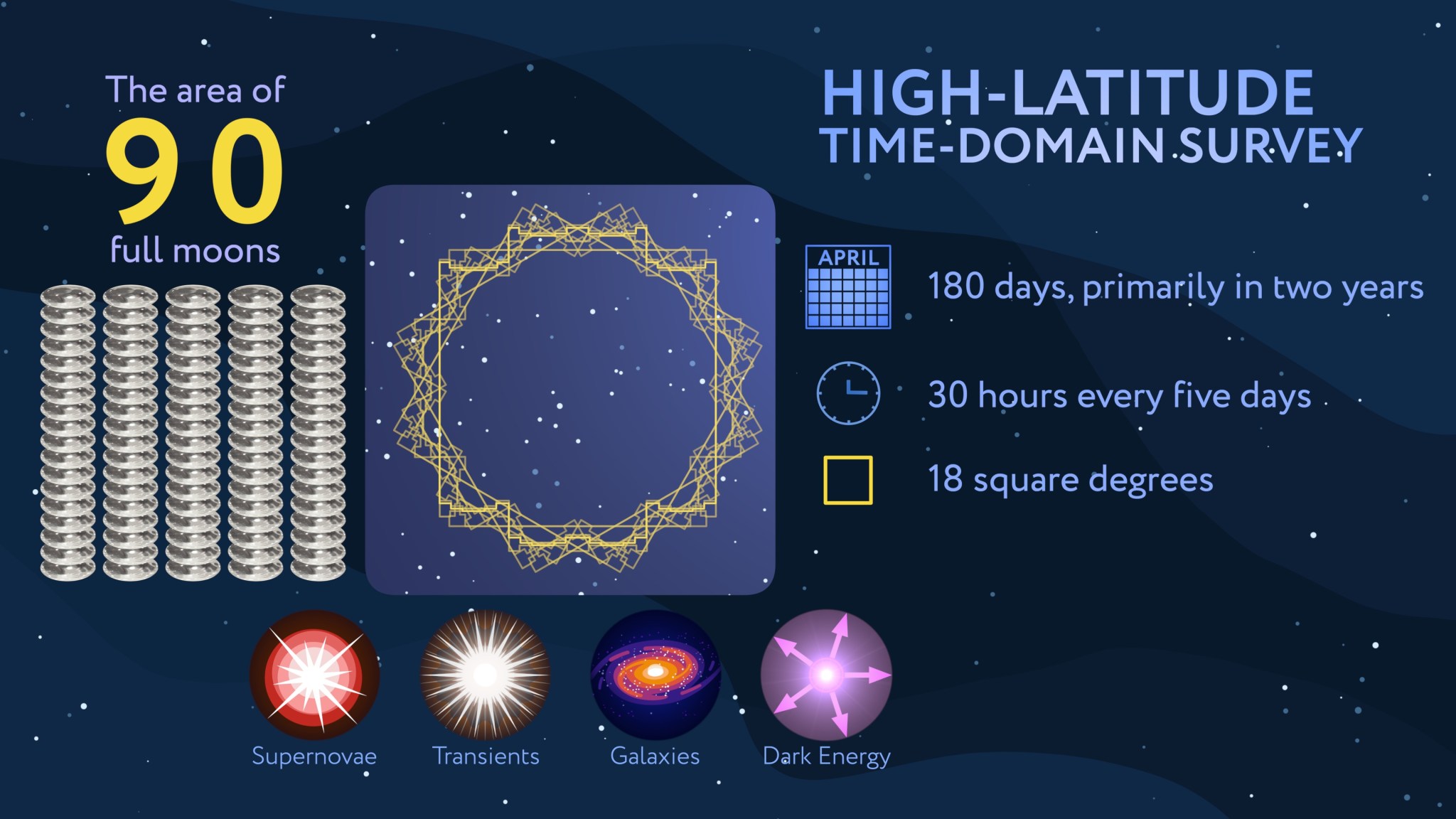
High-Latitude Time-Domain Survey
Roman’s High-Latitude Time-Domain Survey can probe our dynamic universe by observing the same region of the cosmos repeatedly. Stitching these observations together to create movies can allow scientists to study how celestial objects and phenomena change over time periods of days to years.
This survey can probe dark energy by finding and studying many thousands of a special type of exploding star called type Ia supernovae. These stellar cataclysms allow scientists to measure cosmic distances and trace the universe’s expansion.
“Staring at a large volume of the sky for so long will also reveal black holes being born as neutron stars merge, and tidal disruption events –– flares released by stars falling into black holes,” said Saurabh Jha, a professor at Rutgers University in New Brunswick, New Jersey, and ROTAC co-chair. “It will also allow astronomers to explore variable objects, like active galaxies and binary systems. And it enables more open-ended cosmic exploration than most other space telescopes can do, offering a chance to answer questions we haven’t yet thought to ask.”
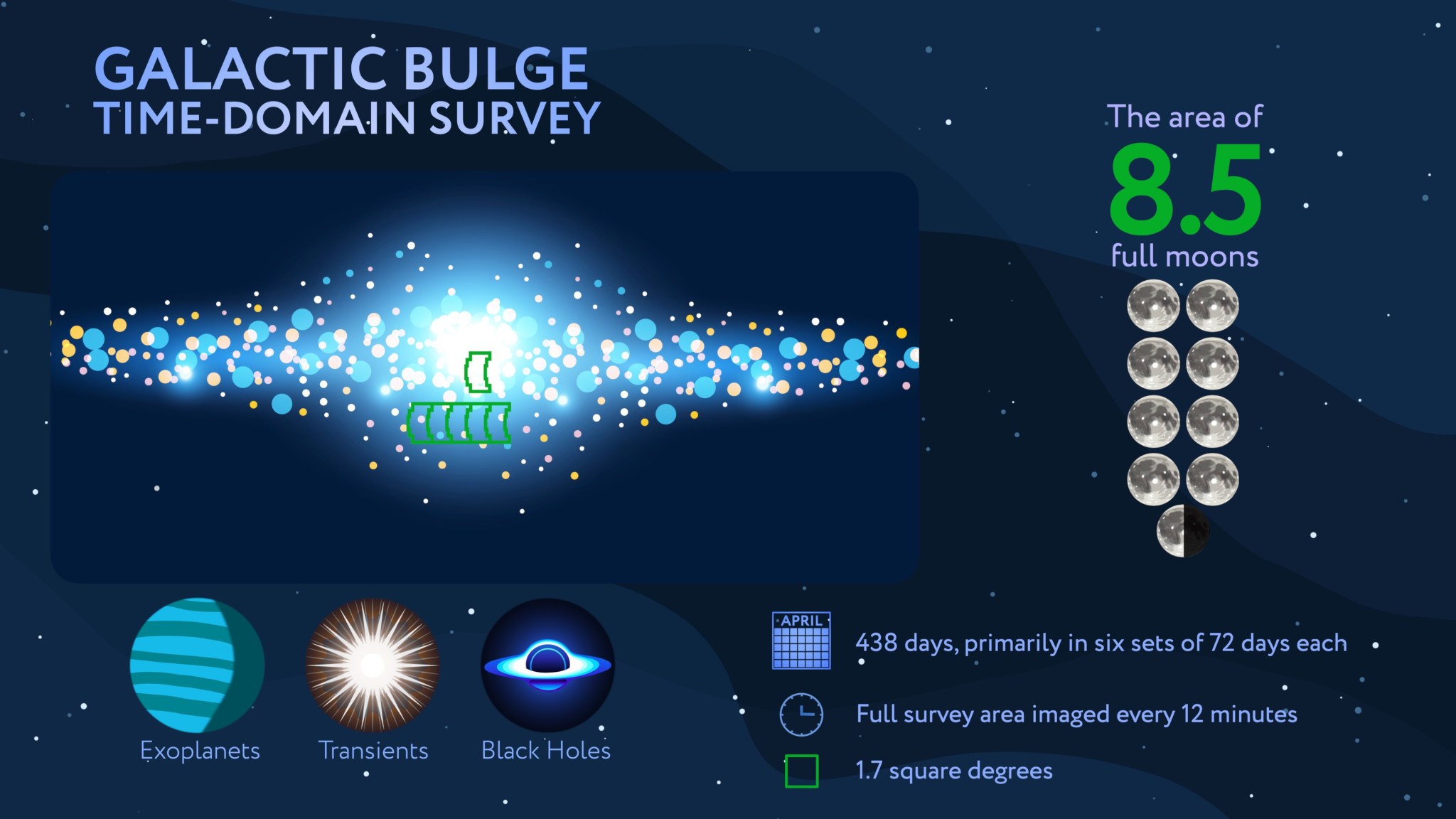
Galactic Bulge Time-Domain Survey
Unlike the high-latitude surveys, Roman’s Galactic Bulge Time-Domain Survey will look inward to provide one of the deepest views ever of the heart of our Milky Way galaxy. Roman’s crisp resolution and infrared view can allow astronomers to watch hundreds of millions of stars in search of microlensing signals — gravitational boosts of a background star’s light that occur when an intervening object passes nearly in front of it. While astronomers have mainly discovered star-hugging worlds, Roman’s microlensing observations can find planets in the habitable zone of their star and farther out, including analogs of every planet in our solar system except Mercury.
The same set of observations can reveal “rogue” planets that drift through the galaxy unbound to any star, brown dwarfs (“failed stars” too lightweight to power themselves by fusion the way stars do), and stellar corpses like neutron stars and white dwarfs. And scientists could discover 100,000 new worlds by seeing stars periodically get dimmer as an orbiting planet passes in front of them, events called transits. Scientists can also study the stars themselves, detecting “starquakes” on a million giant stars, the result of sound waves reverberating through their interiors that can reveal information about their structures, ages, and other properties.
Data from all of Roman’s surveys will be made public as soon as it is processed, with no periods of exclusive access.
“Roman’s unprecedented data will offer practically limitless opportunities for astronomers to explore all kinds of cosmic topics,” McEnery said. “We stand to learn a tremendous amount of new information about the universe very rapidly after the mission launches.”
Quelle: NASA
----
Update: 9.05.2025
.
Key Portion of NASA’s Roman Space Telescope Clears Thermal Vacuum Test
One half of NASA’s nearly complete Nancy Grace Roman Space Telescope just passed a lengthy test to ensure it will function properly in the space environment.
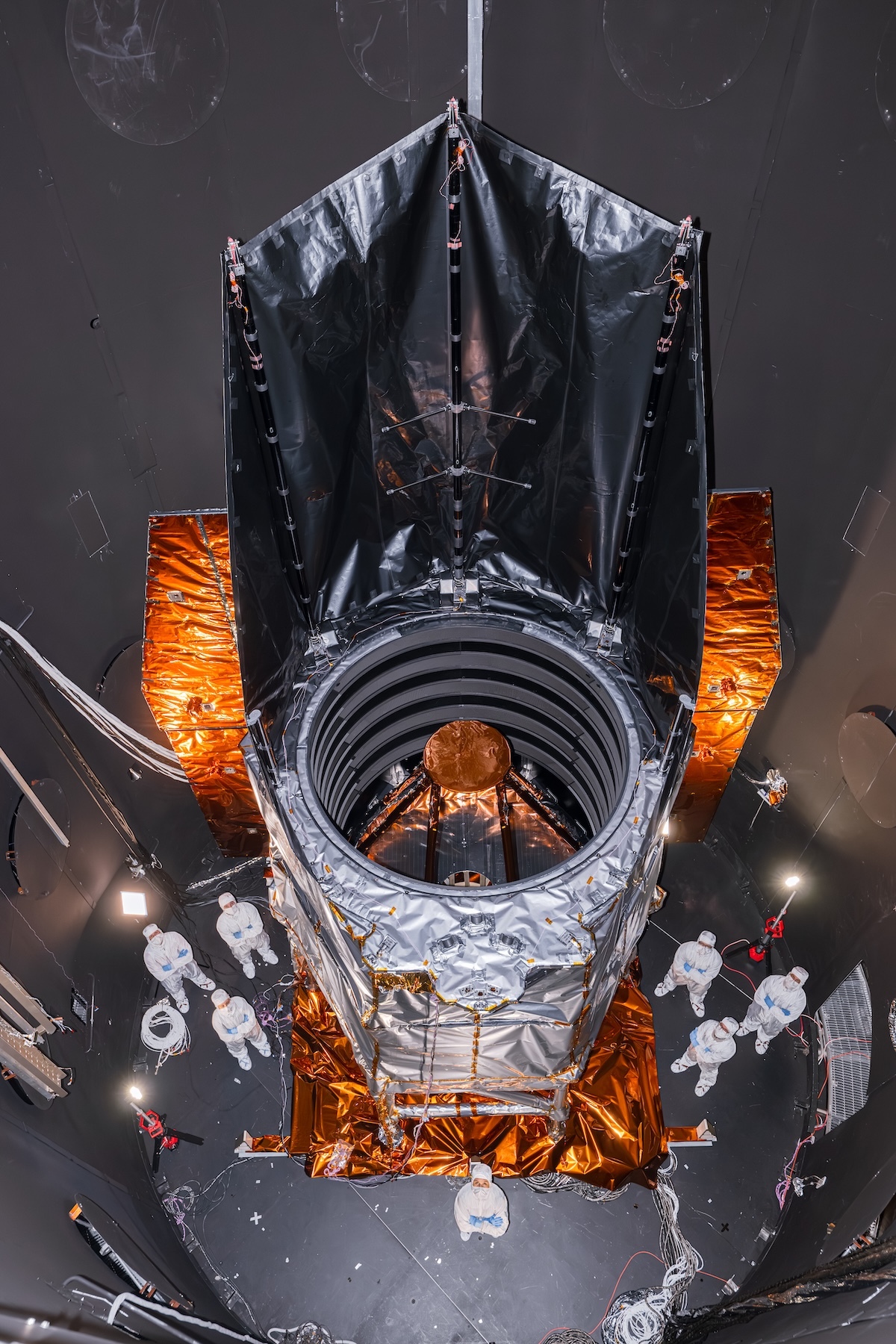
“This milestone tees us up to attach the flight solar array sun shield to the outer barrel assembly, and deployable aperture cover, which we’ll begin this month,” said Jack Marshall, who leads integration and testing for these elements at NASA’s Goddard Space Flight Center in Greenbelt, Maryland. “Then we’ll complete remaining environmental tests for the flight assembly before moving on to connect Roman’s two major assemblies and run the full observatory through testing, and then we’ll be ready to launch!”
Prior to this thermal testing, technicians integrated Roman’s deployable aperture cover, a visor-like sunshade, to the outer barrel assembly, which will house the telescope and instruments, in January, then added test solar panels in March. They moved this whole structure into the Space Environment Simulator test chamber at NASA Goddard in April.
There, it was subjected to the hot and cold temperatures it will experience in space. Next, technicians will join Roman’s flight solar panels to the outer barrel assembly and sunshade. Then the structure will undergo a suite of assessments, including a shake test to ensure it can withstand the vibrations experienced during launch.
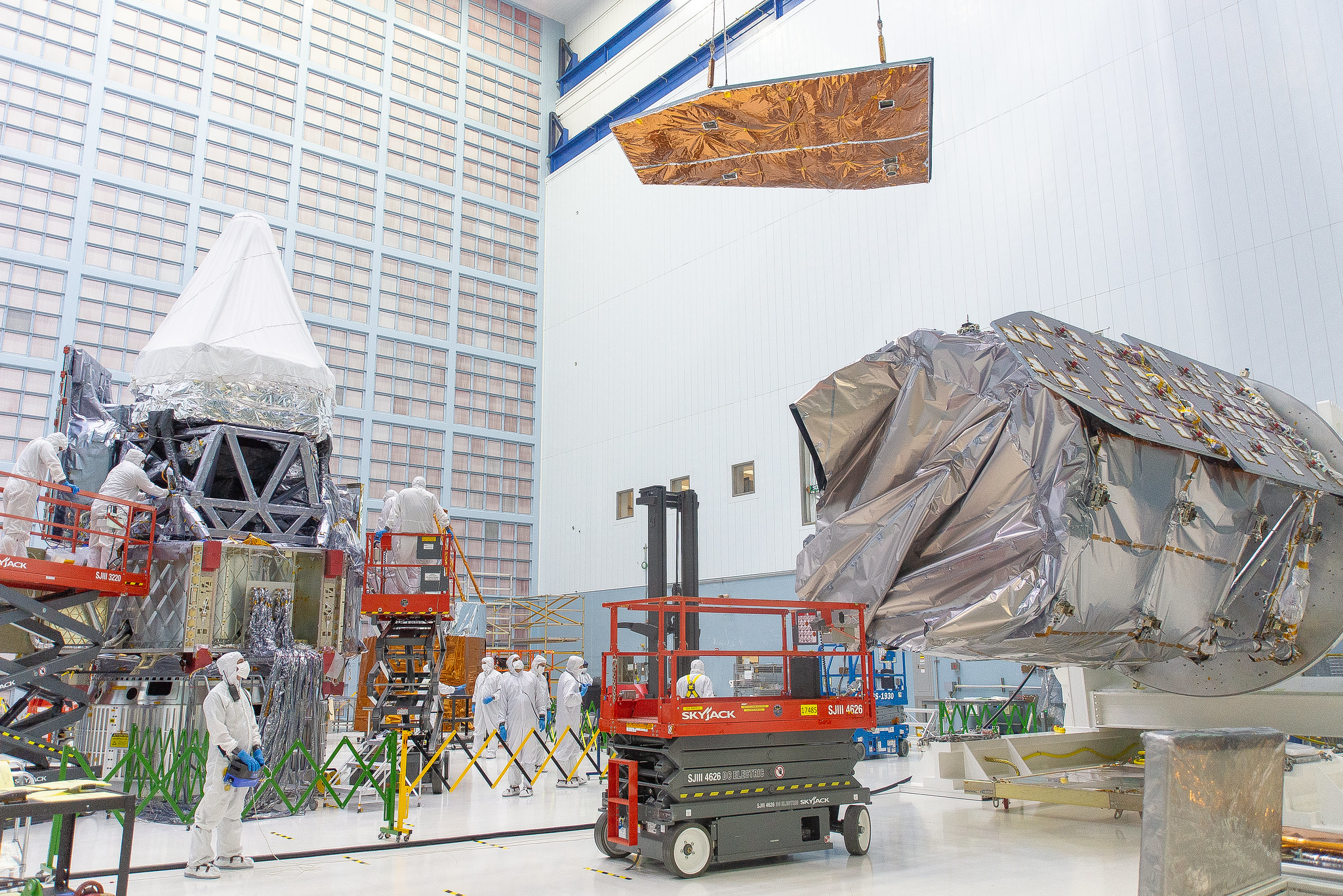
Meanwhile, Roman’s other major portion — the spacecraft and integrated payload assembly, which consists of the telescope, instrument carrier, and two instruments — will undergo its own shake test, along with additional assessments. Technicians will install the lower instrument sun shade and put this half of the observatory through a thermal vacuum test in the Space Environment Simulator.
“The test verifies the instruments will remain at stable operating temperatures even while the Sun bakes one side of the observatory and the other is exposed to freezing conditions — all in a vacuum, where heat doesn’t flow as readily as it does through air,” said Jeremy Perkins, an astrophysicist serving as Roman’s observatory integration and test scientist at NASA Goddard. Keeping the instrument temperatures stable ensures their readings will be precise and reliable.
Technicians are on track to connect Roman’s two major parts in November, resulting in a complete observatory by the end of the year. Following final tests, Roman is expected to ship to the launch site at NASA’s Kennedy Space Center in Florida for launch preparations in summer 2026. Roman remains on schedule for launch by May 2027, with the team aiming for launch as early as fall 2026.
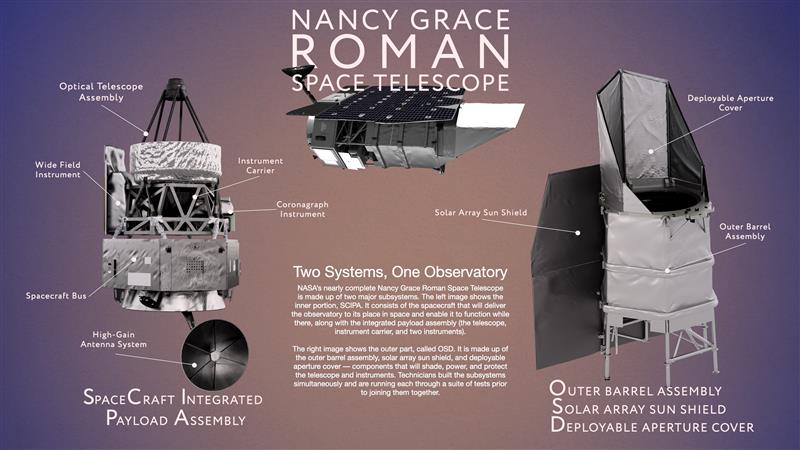
Core Components for NASA’s Roman Space Telescope Pass Major Shake Test
The core portion of NASA’s Nancy Grace Roman Space Telescope has successfully completed vibration testing, ensuring it will withstand the extreme shaking experienced during launch. Passing this key milestone brings Roman one step closer to helping answer essential questions about the role of dark energy and other cosmic mysteries.
“The test could be considered as powerful as a pretty severe earthquake, but there are key differences,” said Cory Powell, the Roman lead structural analyst at NASA’s Goddard Space Flight Center in Greenbelt, Maryland. “Unlike an earthquake, we sweep through our frequencies one at a time, starting with very low-level amplitudes and gradually increasing them while we check everything along the way. It’s a very complicated process that takes extraordinary effort to do safely and efficiently.”
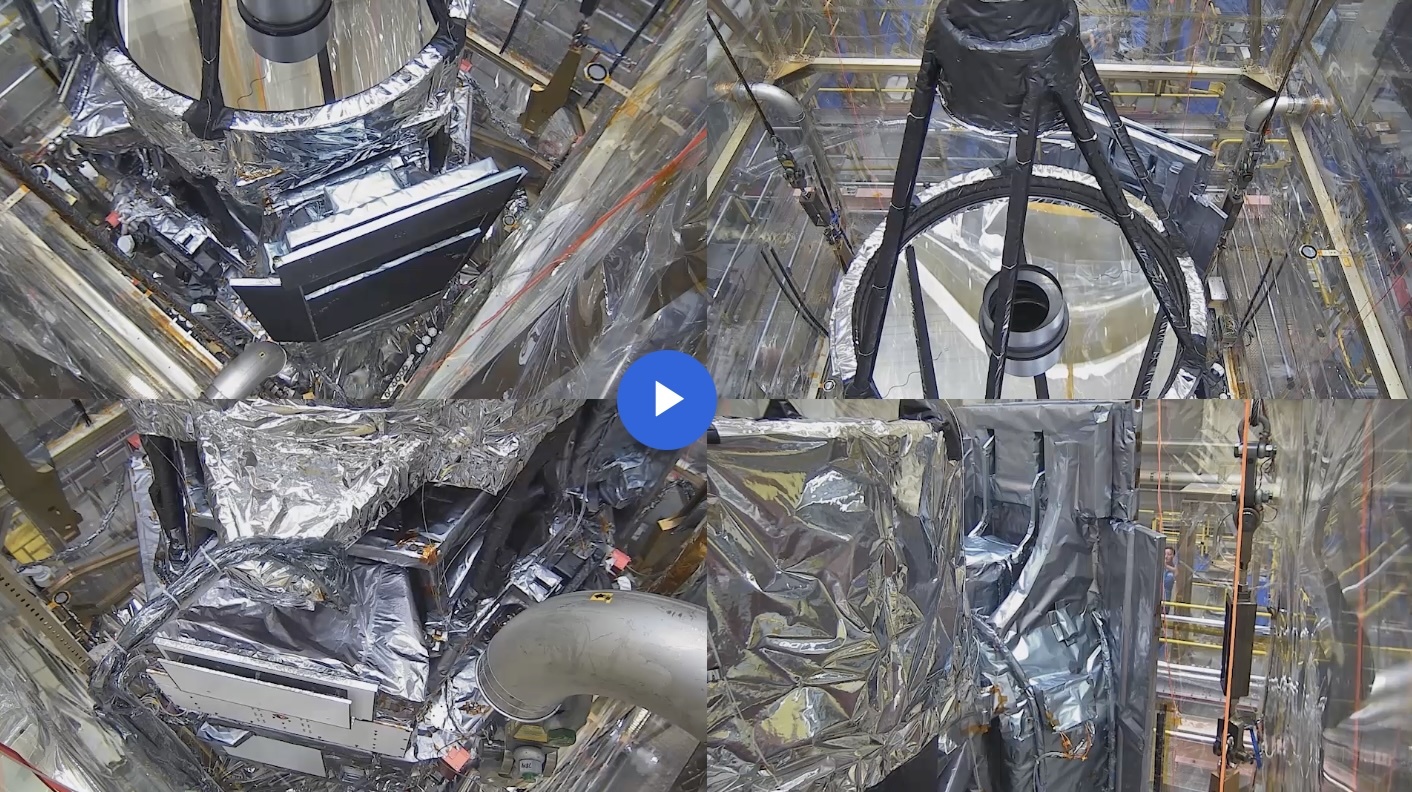
The team simulated launch conditions as closely as possible. “We performed the test in a flight-powered configuration and filled the propulsion tanks with approximately 295 gallons of deionized water to simulate the propellent loading on the spacecraft during launch,” said Joel Proebstle, who led this test, at NASA Goddard. This is part of a series of tests that ratchet up to 125 percent of the forces the observatory will experience.
This milestone is the latest in a period of intensive testing for the nearly complete Roman Space Telescope, with many major parts coming together and running through assessments in rapid succession. Roman currently consists of two major assemblies: the inner, core portion (telescope, instrument carrier, two instruments, and spacecraft) and the outer portion (outer barrel assembly, solar array sun shield, and deployable aperture cover).
Now, having completed vibration testing, the core portion will return to the large clean room at Goddard for post-test inspections. They’ll confirm that everything remains properly aligned and the high-gain antenna can deploy. The next major assessment for the core portion will involve additional tests of the electronics, followed by a thermal vacuum test to ensure the system will operate as planned in the harsh space environment.
In the meantime, Goddard technicians are also working on Roman’s outer portion. They installed the test solar array sun shield, and this segment then underwent its own thermal vacuum test, verifying it will control temperatures properly in the vacuum of space. Now, technicians are installing the flight solar panels to this outer part of the observatory.
The team is on track to connect Roman’s two major assemblies in November, resulting in a whole observatory by the end of the year that will then undergo final tests. Roman remains on schedule for launch by May 2027, with the team aiming for as early as fall 2026.
The Nancy Grace Roman Space Telescope is managed at NASA’s Goddard Space Flight Center in Greenbelt, Maryland, with participation by NASA’s Jet Propulsion Laboratory in Southern California; Caltech/IPAC in Pasadena, California; the Space Telescope Science Institute in Baltimore; and a science team comprising scientists from various research institutions. The primary industrial partners are BAE Systems Inc. in Boulder, Colorado; L3Harris Technologies in Rochester, New York; and Teledyne Scientific & Imaging in Thousand Oaks, California.
Quelle: NASA
